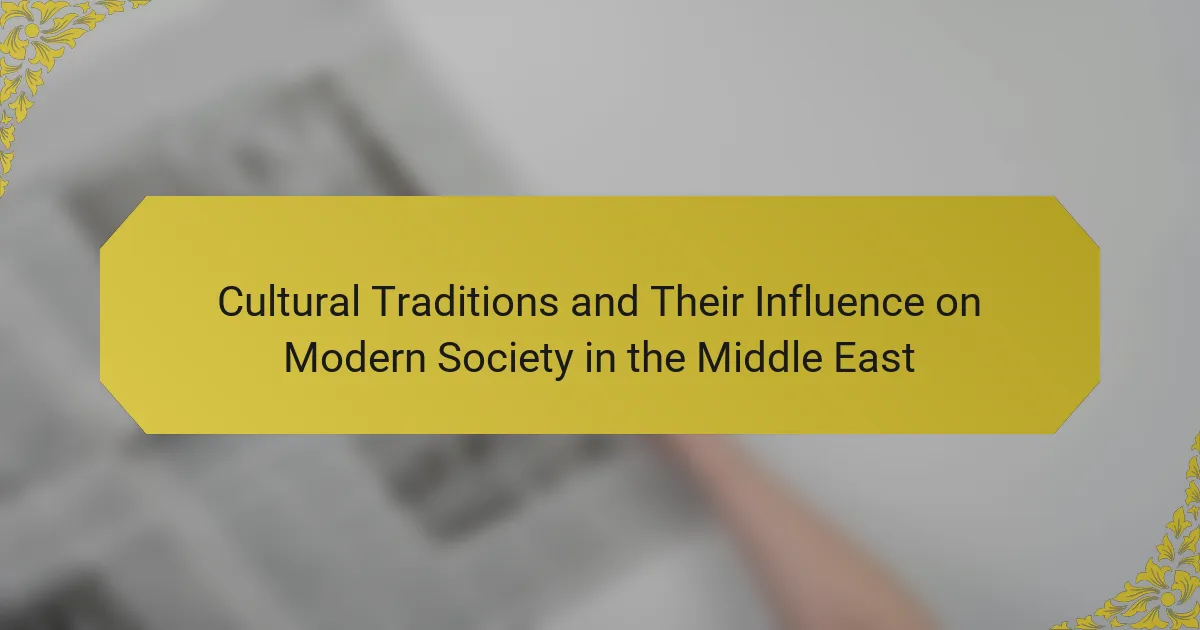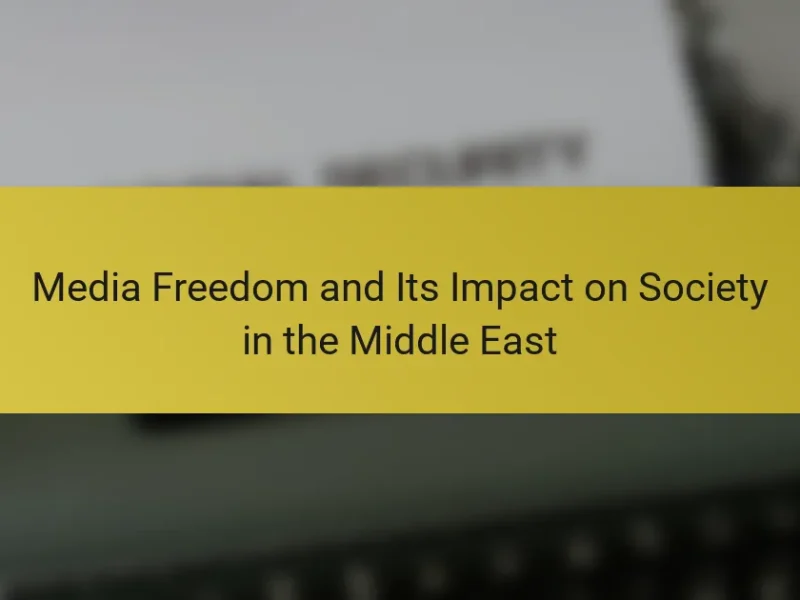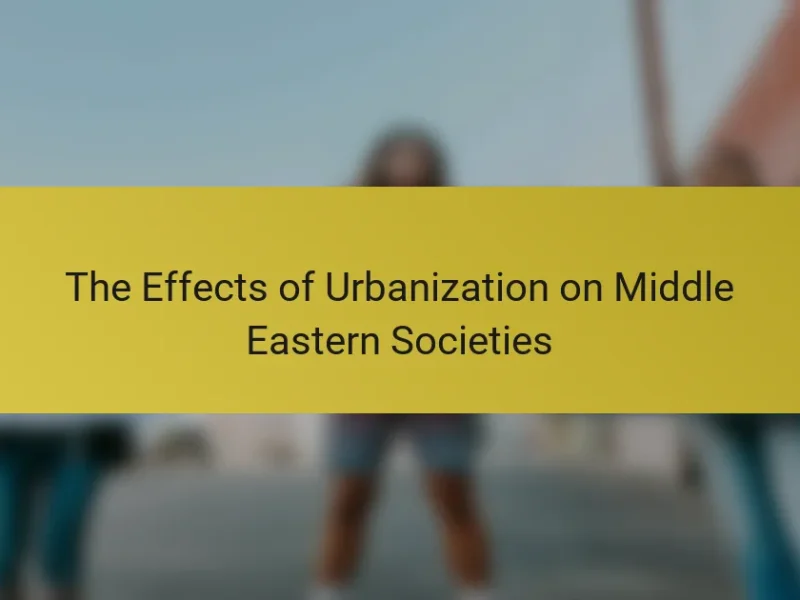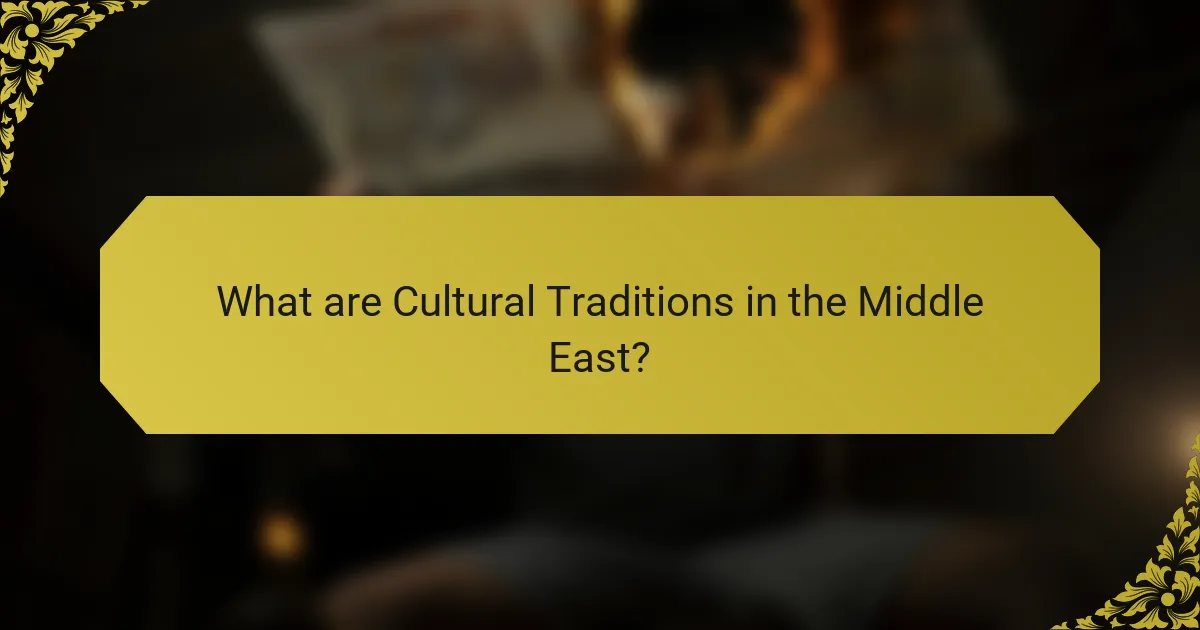
What are Cultural Traditions in the Middle East?
Cultural traditions in the Middle East encompass a diverse array of practices, beliefs, and customs. These traditions are influenced by the region’s history, religion, and social structures. Common elements include hospitality, family values, and religious observances. For instance, hospitality is a cornerstone of Middle Eastern culture, often demonstrated through elaborate meals and gatherings. Family plays a central role, with extended families typically living close together and supporting one another. Religious practices, such as Ramadan and Eid celebrations, significantly shape social life and community interactions. The rich tapestry of art, music, and dance also reflects the region’s cultural heritage. Traditional crafts, such as weaving and pottery, showcase the skills passed down through generations. Overall, these cultural traditions contribute to the identity and cohesion of Middle Eastern societies.
How do cultural traditions shape societal norms in the Middle East?
Cultural traditions significantly shape societal norms in the Middle East. These traditions influence behaviors, values, and social interactions. For instance, family structure in many Middle Eastern societies is often patriarchal, reflecting cultural values of respect and authority. Community gatherings and religious practices reinforce social cohesion and shared identity. Traditions surrounding hospitality dictate social etiquette, impacting how individuals interact with guests and neighbors. Additionally, cultural rituals and festivals serve to strengthen communal ties and preserve historical narratives. The importance of honor and reputation in these societies often stems from longstanding cultural beliefs. Overall, cultural traditions are integral to understanding the societal framework in the Middle East.
What are the key characteristics of Middle Eastern cultural traditions?
Middle Eastern cultural traditions are characterized by a rich tapestry of customs, beliefs, and practices. These traditions often emphasize family values and community cohesion. Hospitality is a fundamental aspect, where guests are treated with great respect and generosity. Religious practices, predominantly [censured], shape many cultural norms and celebrations. Traditional music and dance play vital roles in social gatherings and festivals. Art forms, including calligraphy and pottery, reflect historical and religious significance. Culinary traditions highlight the use of spices and communal meals. Language and storytelling are crucial for preserving history and cultural identity. Overall, these characteristics demonstrate the depth and diversity of Middle Eastern culture.
How do historical events influence these traditions?
Historical events shape cultural traditions significantly. They often serve as catalysts for the development and evolution of these traditions. For instance, the Islamic conquests in the 7th century introduced new practices and beliefs that integrated with existing customs. The Ottoman Empire’s rule further influenced regional traditions by merging various cultural elements from different societies. Events such as colonialism also impacted local traditions, often leading to a blend of indigenous and foreign customs. Additionally, conflicts and revolutions can reshape traditions as communities respond to changing political landscapes. Historical narratives and collective memories contribute to how these traditions are perceived and practiced today.
Why are cultural traditions important in the Middle East?
Cultural traditions are important in the Middle East because they preserve identity and heritage. They provide a sense of belonging and continuity among communities. Traditions shape social norms and values, influencing daily life and interactions. They play a role in religious practices, which are central to many Middle Eastern societies. Festivals and rituals foster community cohesion and collective memory. Historical events, such as the spread of [censured], have solidified cultural practices over centuries. Additionally, cultural traditions contribute to the region’s diversity, showcasing a rich tapestry of languages, arts, and cuisines. This cultural richness attracts tourism and promotes economic development.
What role do these traditions play in community identity?
Cultural traditions play a crucial role in shaping community identity. They provide a sense of belonging and continuity among members. These traditions often reflect shared values, beliefs, and historical experiences. For example, communal celebrations reinforce social bonds and cultural heritage. In the Middle East, traditions like storytelling and music preserve historical narratives. They also promote social cohesion and collective memory. Research indicates that communities with strong traditions exhibit higher levels of social trust and cooperation. Thus, these traditions are integral to the identity and unity of communities.
How do they affect interpersonal relationships?
Cultural traditions significantly affect interpersonal relationships in the Middle East. They shape values, communication styles, and social norms. For instance, traditions emphasizing family loyalty foster close-knit relationships. In contrast, customs dictating gender roles can create barriers in communication. Research shows that collectivist cultures, like those in the Middle East, prioritize group harmony over individual expression. This can lead to stronger bonds but may suppress personal opinions. Additionally, rituals and celebrations strengthen social ties. They provide opportunities for community bonding and support. Overall, cultural traditions play a crucial role in defining how individuals relate to one another.
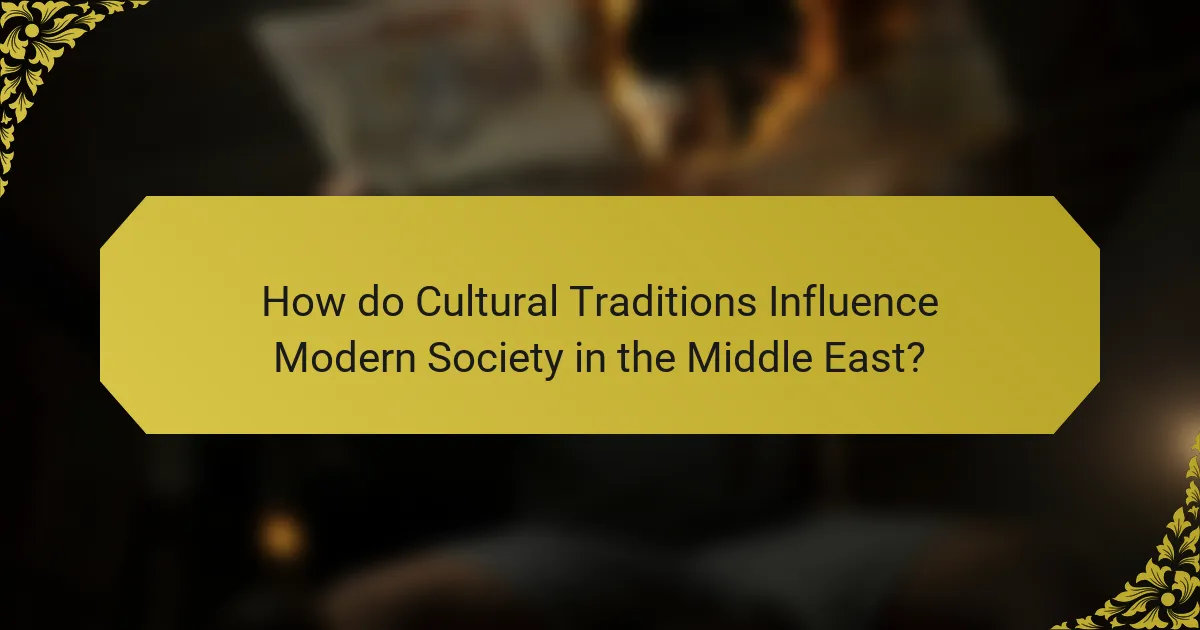
How do Cultural Traditions Influence Modern Society in the Middle East?
Cultural traditions significantly influence modern society in the Middle East. These traditions shape social norms, values, and behaviors. For instance, family structures in Middle Eastern societies often reflect traditional values emphasizing respect and loyalty. Festivals and religious observances, such as Ramadan and Eid, reinforce community bonds and cultural identity. Traditional dress and cuisine also play a role in maintaining cultural heritage. Educational systems often integrate cultural teachings, influencing youth perspectives. Additionally, art and literature are deeply rooted in cultural traditions, impacting contemporary expressions. Overall, cultural traditions serve as a foundation for societal cohesion and identity in the Middle East.
What impact do cultural traditions have on contemporary social practices?
Cultural traditions significantly shape contemporary social practices in the Middle East. These traditions influence family structures, social interactions, and community values. For example, respect for elders remains a core value, affecting how younger generations engage with their families. Traditional celebrations, such as Eid and Ramadan, foster community bonding and shared experiences. Gender roles, often rooted in cultural customs, dictate social behavior and expectations. Additionally, cultural traditions guide hospitality norms, impacting social gatherings and interactions. The preservation of these practices helps maintain a sense of identity amidst globalization. Studies show that communities that uphold their traditions experience stronger social cohesion.
How do these traditions manifest in everyday life?
Cultural traditions in the Middle East manifest in everyday life through various practices and rituals. Daily routines often incorporate traditional customs, such as specific meal preparations during Ramadan. Family gatherings frequently include storytelling that reflects cultural heritage. Clothing choices often feature traditional garments, like the abaya or keffiyeh, symbolizing cultural identity. Festivals, such as Eid, are celebrated with communal prayers and feasting, reinforcing community bonds. Social interactions often involve greetings that reflect respect and hospitality, such as “As-salamu alaykum.” Traditional music and dance are integral during celebrations and gatherings. These manifestations help preserve cultural identity while adapting to modern influences.
In what ways do they influence modern family structures?
Cultural traditions significantly influence modern family structures in the Middle East. These traditions shape familial roles, expectations, and relationships. Traditional values often emphasize extended family living arrangements. This can lead to multi-generational households where grandparents, parents, and children coexist. Gender roles are also affected, with expectations for men to be providers and women to manage the household.
Moreover, cultural norms dictate marriage practices, often favoring arranged marriages. This impacts the choice of partners and the dynamics within families. Family honor and reputation play crucial roles in decision-making processes. In many cases, this leads to strong family loyalty and support systems.
Research indicates that these traditions are evolving due to globalization and modernization. However, core values still persist, influencing how families interact and function. The interplay of tradition and modernity creates a unique family structure in the region.
How do cultural traditions affect economic activities in the region?
Cultural traditions significantly influence economic activities in the Middle East. These traditions shape consumer behavior and market demand. For example, religious practices dictate specific times for shopping and consumption. Festivals and holidays boost sales in sectors like food and retail. Additionally, traditional crafts and products create niche markets. The preservation of cultural heritage can attract tourism, enhancing local economies. Overall, cultural traditions are intertwined with economic practices, driving both local and regional economic growth.
What industries are shaped by these traditions?
Cultural traditions in the Middle East shape several key industries. The tourism industry is significantly influenced by cultural heritage sites and festivals. Traditional crafts and artisanal products also thrive due to cultural practices. The culinary industry benefits from the region’s rich food traditions, attracting both locals and visitors. Additionally, the fashion industry is impacted by traditional clothing and textile practices. Lastly, the entertainment industry often incorporates traditional music and dance, reflecting cultural narratives. These industries collectively showcase the deep-rooted traditions that continue to influence modern economic activities in the region.
How do they influence consumer behavior?
Cultural traditions influence consumer behavior by shaping preferences and purchasing decisions. These traditions dictate values, beliefs, and social norms that affect how individuals perceive products. For example, in the Middle East, cultural practices emphasize hospitality and generosity. This leads consumers to favor larger quantities and premium products for gatherings. Additionally, cultural symbols and colors play a significant role in marketing strategies. Brands often align their messaging with local customs to enhance relatability. Research indicates that culturally relevant advertisements increase consumer engagement and loyalty. This connection between culture and consumption underscores the importance of understanding local traditions in marketing.
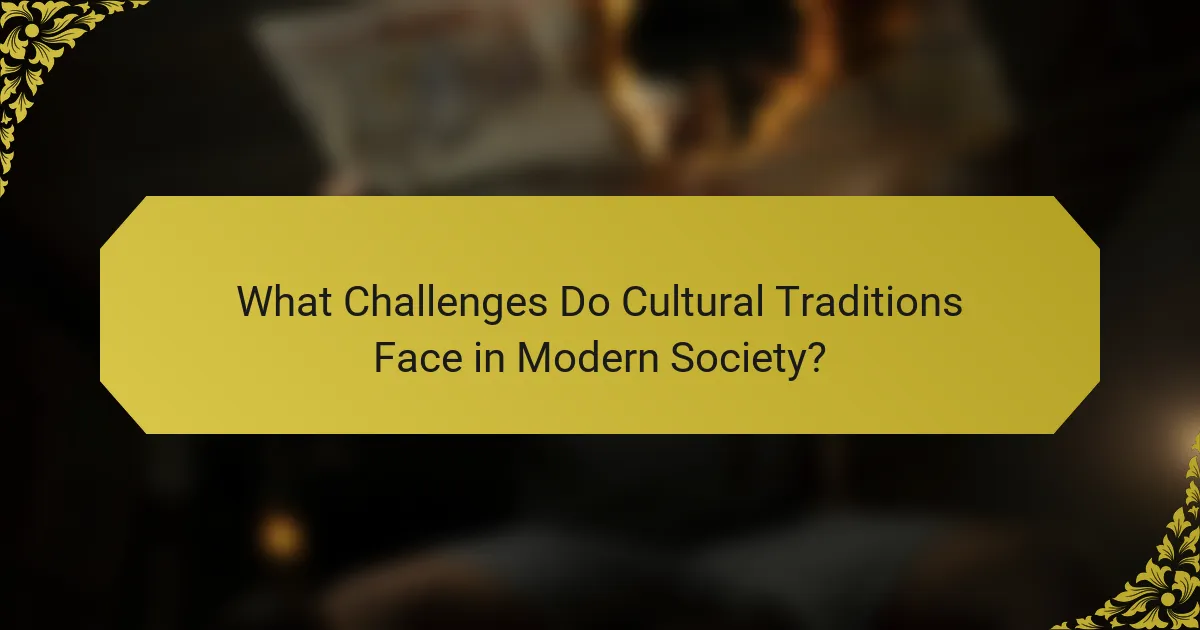
What Challenges Do Cultural Traditions Face in Modern Society?
Cultural traditions face significant challenges in modern society. Rapid globalization often leads to the dilution of unique cultural identities. Increased access to technology promotes a more homogenized culture. Younger generations may prioritize modern values over traditional practices. Urbanization can disrupt community bonds that sustain cultural traditions. Economic pressures may force communities to abandon rituals for financial stability. Additionally, migration can result in cultural displacement and loss. These factors contribute to the ongoing struggle to preserve cultural heritage in a changing world.
How do globalization and modernization impact cultural traditions?
Globalization and modernization significantly influence cultural traditions by promoting cultural exchange and altering local practices. Globalization facilitates the spread of ideas, values, and customs across borders. This leads to the blending of traditional practices with global trends. For instance, Middle Eastern youth increasingly adopt Western fashion and entertainment. Modernization often encourages urbanization, which can dilute rural traditions. As communities move to cities, traditional practices may be replaced or modified. Additionally, technology enables rapid information sharing, impacting how traditions are perceived and practiced. Research shows that cultural homogenization occurs as global influences permeate local customs. A study by the Pew Research Center highlights that younger generations in the Middle East are more open to diverse cultural influences. This shift can lead to both the preservation and transformation of cultural traditions.
What are the risks of cultural erosion?
Cultural erosion poses significant risks to identity and heritage. It can lead to the loss of traditional practices and languages. This diminishes community cohesion and social bonds. Moreover, cultural erosion can result in homogenization, where diverse cultures become indistinguishable. This often occurs due to globalization and the dominance of popular culture. Historical examples show that indigenous practices can vanish within a few generations. The United Nations Educational, Scientific and Cultural Organization (UNESCO) reports that over 2,500 languages are at risk of extinction. These factors highlight the urgent need to preserve cultural diversity.
How do younger generations perceive these traditions?
Younger generations often view cultural traditions with a mix of respect and skepticism. They recognize the importance of traditions in shaping identity and community. However, many feel that some practices are outdated or restrictive. This generation seeks to balance tradition with modern values. For instance, studies show that younger individuals prioritize personal freedom and innovation. A survey conducted by the Arab Youth Survey in 2021 indicated that 60% of young Arabs believe traditions should evolve. This reflects a desire for cultural relevance in a rapidly changing world.
What are the strategies to preserve cultural traditions in a modern context?
Strategies to preserve cultural traditions in a modern context include education, community engagement, and technology use. Education fosters awareness of cultural heritage among younger generations. Schools can incorporate local history and traditions into their curricula. Community engagement encourages participation in cultural events and practices. Festivals, workshops, and exhibitions can showcase traditional arts and crafts. Technology can enhance preservation efforts through digital archives and social media. Online platforms allow for the sharing of cultural stories and practices globally. Collaborations with cultural organizations can also strengthen preservation initiatives. These strategies collectively help maintain cultural identity in a rapidly changing world.
How can communities engage in cultural revitalization?
Communities can engage in cultural revitalization by actively preserving and promoting their cultural heritage. This can be achieved through organizing cultural festivals, workshops, and educational programs that celebrate traditional practices. For instance, communities can host events showcasing traditional music, dance, and crafts. Collaborating with local artists and cultural experts can enhance these initiatives. Additionally, documenting oral histories and traditional stories helps keep cultural narratives alive. Research indicates that such activities strengthen community identity and cohesion. A study by the International Journal of Cultural Studies found that cultural festivals significantly boost local engagement and pride.
What role do education and policy play in this preservation?
Education and policy play crucial roles in the preservation of cultural traditions in the Middle East. Education fosters awareness and appreciation of cultural heritage among younger generations. Schools and universities often include curricula that emphasize local history and traditions. This educational approach helps instill a sense of identity and belonging.
Policies also support preservation efforts by providing frameworks for cultural initiatives. Governments may establish regulations that protect historical sites and promote traditional practices. For example, UNESCO has recognized several Middle Eastern sites as World Heritage Sites, highlighting their cultural significance.
Additionally, policies can allocate funding for cultural programs and festivals. Such initiatives encourage community participation and engagement with cultural traditions. Research indicates that countries with strong cultural policies see better preservation outcomes. This dual focus on education and policy creates a sustainable environment for cultural traditions to thrive.
What practical steps can individuals take to honor and promote cultural traditions?
Individuals can honor and promote cultural traditions by actively participating in local cultural events. These events often showcase traditional music, dance, and food. Attending festivals helps preserve and celebrate cultural heritage.
Another practical step is to learn and practice traditional crafts or skills. This can include weaving, pottery, or cooking traditional dishes. Engaging in these activities keeps cultural practices alive.
Sharing knowledge about cultural traditions with younger generations is also crucial. Teaching children the significance of customs fosters appreciation and continuity.
Additionally, supporting local artisans and businesses that represent cultural heritage helps sustain these traditions. Purchasing handmade goods contributes to the local economy and promotes cultural identity.
Volunteering for community cultural organizations can further enhance awareness. These organizations often work to preserve and promote cultural practices.
Finally, using social media to share cultural stories and experiences can reach a wider audience. This modern approach helps keep traditions relevant in today’s society.
Cultural traditions in the Middle East serve as the primary entity of this article, highlighting their significance in shaping modern society. The article explores how these traditions influence societal norms, family structures, and interpersonal relationships, while also addressing the impact of historical events and globalization. Key characteristics such as hospitality, religious practices, and community cohesion are examined, alongside the challenges faced in preserving these traditions amidst modern influences. Additionally, strategies for cultural revitalization and the role of education and policy in preserving heritage are discussed, providing a comprehensive overview of the interplay between cultural traditions and contemporary life in the region.
